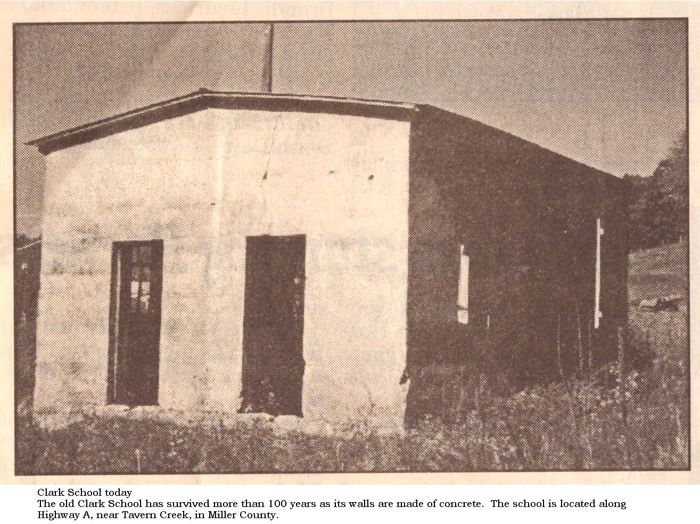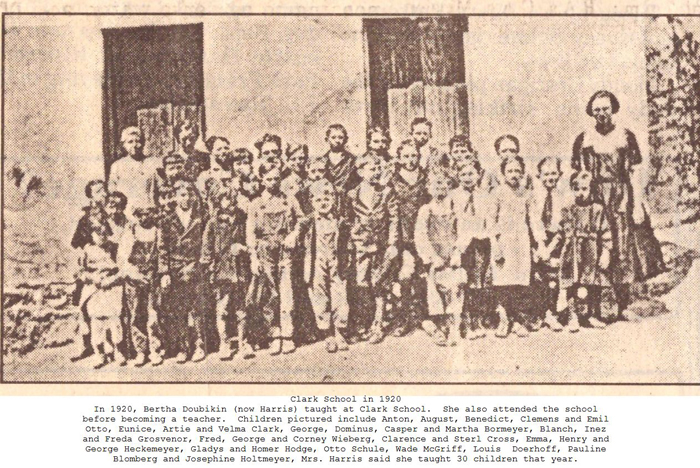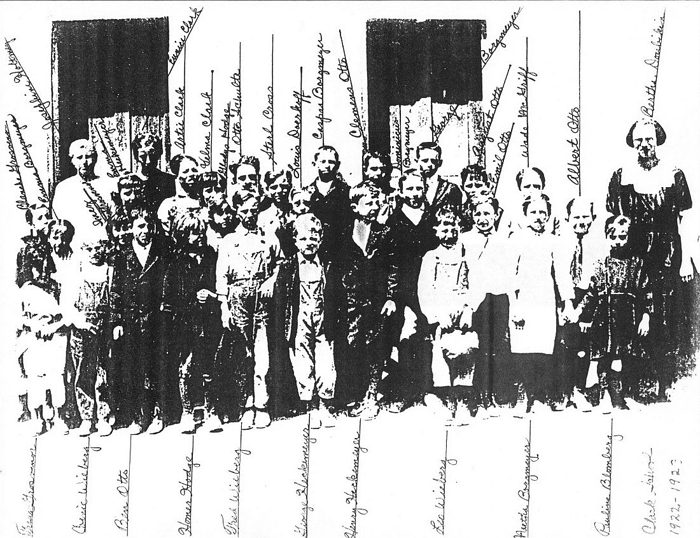
School Name: Clark (or Otto) School School District Number: #xxx
Location:
Township: Twn40N Range: Rng12W Section: Sec29
Latitude: xx°N Longitude: xx°W
School Photos:
School Information:
Date Started: Date Closed:
Teachers:
| 1874-75 | W. R. Short | 1888-89 | David Farnham | |
| 1875-76 | Renault C. Clark | 1889-92 | Robert B. Thompson | |
| 1876-77 | W. M. Gott | 1892-93 | W. E. Allen | |
| 1877-78 | Fredrick A. Goodrich | 1893-94 | Delila Palmer | |
| 1878-79 | Fred A. Goodrich | 1894-95 | V. H. Goethe | |
| 1879-80 | W. M. Gott | 1895-96 | William Perry | |
| 1880-81 | John W. Brockman | 1896-97 | E. F. Madden | |
| 1881-82 | D. W. Baker | 1897-98 | C. Murcersmith | |
| 1882-83 | Robert Garner | 1898-99 | Martha Bear | |
| 1883-84 | J. L. McComb | 1899-00 | James Murcersmith | |
| 1884-85 | J. L. Watson | 1900-01 | James Messersmith | |
| 1885-87 | John W. Waite | |||
| 1887-88 | J. L. Winningham |
Later teachers included:
| 1914 | Mae Mace Perkins |
School Information: by Ray Doefhoff
This schoolhouse is located in the center of Section 29, which is the exact center of the original district boundaries. This building is still standing on the William Brand farm and is the concrete structure, below the Brand home, that is visible from highway A. According to Judge Jenkins this was also known as the Otto School at one time. The building was built by the Clark family in 1885 and several Clark families are listed as resident tax payers in 1871.
Clark School still stands along Hwy. A
Written from information compiled by Bertha Harris
Schools that children attend now are far different from the one or sometimes two-room school houses past generations attended. One of those old schools - - Clark School - - still stands oday, 115 years after it was built in 1885. It is located on Highway A in Miller County, near the Tavern Creek Bridge.
Highway A follows the old Tuscumbia – Vienna Road, a one-time short cut between two county seats. The state road winds through rolling Ozark hills, and originally was an old trail.
Clark School was built of solid concrete, which is why it has survived more than a century. The nearby Tavern Creek Bridge, a concrete structure, once was a suspension or “swinging bridge.” Before the swinging bridge was built, the crossing was simply a ford.
Clark School stands on a small, level knoll. Bertha Harris was one of the children who attended the school before districts were consolidated and rural schools began closing. She also taught there.
Parents of the students built the school. Two doors lead into the building, with one used by the boys and one the girls. Mrs. Harris said she can still see the pupils marching in as the teacher rang her bell. She said a bucket provided drinking water, with two students carrying it from the spring each day. A wood stove provided heat in the winter.
Recess featured ballgames, and students performed recitations and had math contests. The last day of school often featured a cyphering match or spelling bee. Parents brought dinner and watched the contests and listened to poetry readings and recitations. A small play might also be performed before children left school to help with farm work during the warm months. The final activity was promotions to the next grade for each student.
Generations of children learned at Clark School. It may stand for many more generations, giving silent testimony and holding silent memories of rural life and education in the 1800s and early 1900s.
CLARK SCHOOL
By Peggy Smith Hake
A few weeks ago I told you about an old deserted school sitting in a valley in the Big Tavern country of Osage Township. It is called the old Clark School and after my article appeared, I received a phone call from Mrs. Mae Mace Perkins and she told me a wonderful story about the old school. At the age of 15, she taught school there for one term of 8 months.
The school is not the original one that was first built. The first one was destroyed by fire sometime around the turn of the century. This second school was constructed of gravel and concrete which will probably stand for many, many years. The year she taught there (1914), the school had ten desks in it; five in a line on each side of an old heating stove. The building was very small and could not hold very many desks nor students.
At the beginning of her school term, Mae boarded with the Walter Doubikin family at their home located approximately 1 1/2 miles west of the school. But on several occasions, the Big Tavern rose so high she could not cross it and the majority of the students lived on the east side of the creek. She decided to board with a family on the east side of the Tavern and was invited to live in the Otto home located in the small village of St. Anthony. The home was situated across the street from the original Catholic Church built there around 1905.
One of her students, Cecelia Otto (who later became Mrs. Adolph Dickneite) and Mae walked over 4 miles to school each day and she could remember so vividly how they had to do all the janitorial chores and had to build fires each day before classes could begin! They would trudge home each evening over 4 miles of hills and valleys to reach St. Anthony.
The only thing I can say is this…I salute these teachers of Miller County’s past days. They were of a completely different breed. Today’s teachers have a very “cushy” life when compared to these dedicated people who faced many hardships in their daily life of teaching to a different generation. I just want all former teachers of these old schools (and there are still few left today) to know how very much I admire you and the wonderful job you all performed educating our unlearned Ozark ancestors.
School Resources


